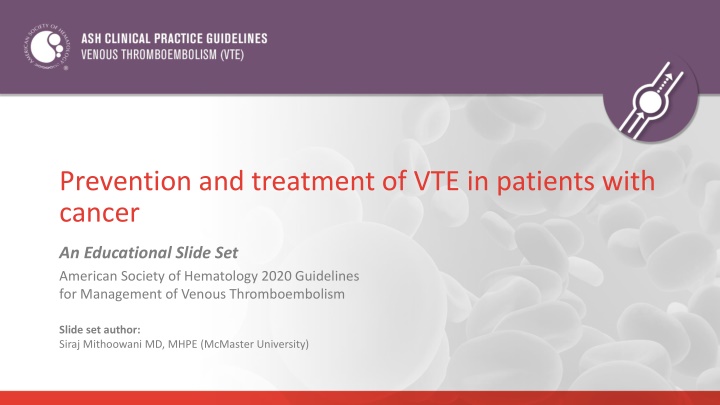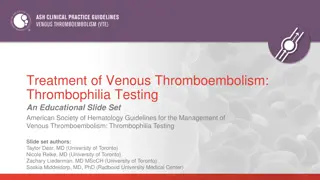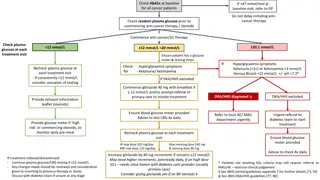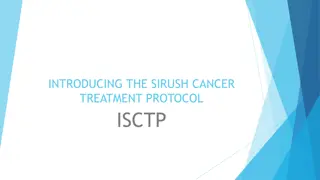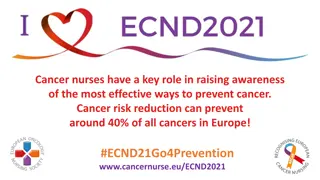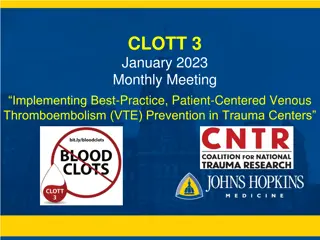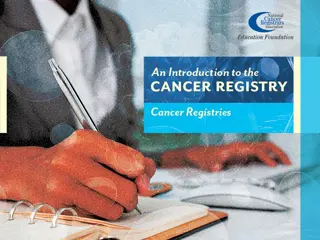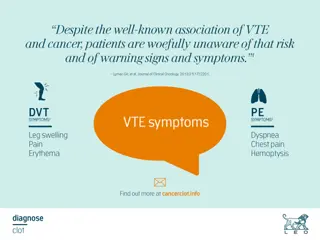Guidelines for Prevention and Treatment of VTE in Cancer Patients
American Society of Hematology's 2020 guidelines address the prevention and treatment of venous thromboembolism (VTE) in cancer patients. Developed by experts, these guidelines focus on key clinical questions, evidence synthesis, and recommendations for managing VTE in this specific population. The guideline development process ensures a balanced panel with diverse expertise and a thorough review of available evidence. Patients and clinicians are recommended to follow the strong and conditional recommendations provided in the guidelines to enhance VTE prevention and treatment strategies in cancer care.
Download Presentation

Please find below an Image/Link to download the presentation.
The content on the website is provided AS IS for your information and personal use only. It may not be sold, licensed, or shared on other websites without obtaining consent from the author.If you encounter any issues during the download, it is possible that the publisher has removed the file from their server.
You are allowed to download the files provided on this website for personal or commercial use, subject to the condition that they are used lawfully. All files are the property of their respective owners.
The content on the website is provided AS IS for your information and personal use only. It may not be sold, licensed, or shared on other websites without obtaining consent from the author.
E N D
Presentation Transcript
Prevention and treatment of VTE in patients with cancer An Educational Slide Set American Society of Hematology 2020 Guidelines for Management of Venous Thromboembolism Slide set author: Siraj Mithoowani MD, MHPE (McMaster University)
Clinical Guidelines American Society of Hematology 2020 Guidelines for Management of Venous Thromboembolism: Prevention and Treatment in Patients with Cancer Gary H. Lyman, Marc Carrier, Cihan Ay, Marcello Di Nisio, Lisa K. Hicks, Alok A. Khorana, Andrew Leavitt, Agnes Y Y Lee, Fergus Macbeth, Rebecca L. Morgan, Simon Noble, Elizabeth Sexton, David Stenehjem, Wojtek Wiercioch, Lara A. Kahale, Pablo Alonso-Coello
ASH Clinical Practice Guidelines on VTE 1. 2. 3. 4. 5. 6. 7. 8. 9. 10. Diagnosis of VTE 11. VTE in Latin America 12. Anticoagulation in Patients with COVID-19 Prevention of VTE in Surgical Hospitalized Patients Prevention of VTE in Medical Hospitalized Patients Treatment of Acute VTE (DVT and PE) Optimal Management of Anticoagulation Therapy Prevention and Treatment of VTE in Patients with Cancer Heparin-Induced Thrombocytopenia (HIT) Thrombophilia Pediatric VTE VTE in the Context of Pregnancy
How were these ASH guidelines developed? PANEL FORMATION Each guideline panel was formed following these key criteria: Balance of expertise (including disciplines beyond hematology, and patients) Close attention to minimization and management of COI CLINICAL QUESTIONS 10 to 20 clinically- relevant questions generated in PICO format (population, intervention, comparison, outcome) EVIDENCE SYNTHESIS Evidence summary generated for each PICO question via systematic review of health effects plus: Resource use Feasibility Acceptability Equity Patient values and preferences MAKING RECOMMENDATIONS Recommendations made by guideline panel members based on evidence for all factors. Example: PICO question Should pre-operative thromboprophylaxis vs. post- operative thromboprophylaxis be used in patients with cancer undergoing a surgical procedure? ASH guidelines are reviewed annually by expert work groups convened by ASH. Resources, such as this slide set, derived from guidelines that require updating are removed from the ASH website.
How patients and clinicians should use these recommendations STRONG Recommendation ( The panel recommends ) CONDITIONAL Recommendation ( The panel suggests ) Most individuals would want the intervention. A majority would want the intervention, but many would not. For patients Different choices will be appropriate for different patients, depending on their values and preferences. Use shared decision making. Most individuals should receive the intervention. For clinicians
Objectives By the end of this session, you should be able to 1. Describe recommendations for primary prophylaxis in patients with cancer undergoing surgery 2. Describe recommendations for primary prophylaxis in ambulatory patients with cancer receiving systemic therapy 3. Select appropriate anticoagulant therapy for VTE in patients with cancer 4. Describe recommendations for treatment of incidental PE in patients with cancer
What is this chapter about? Patients with cancer are at greater risk for VTE than the general population resulting in considerable morbidity, mortality and costs Treatment decisions should be individualized taking into account consequences of VTE and/or bleeding events This chapter provides evidence-based recommendations on prevention and treatment of VTE in patients with cancer
Case 1: Primary prophylaxis in patients with cancer undergoing surgery 67 year old female with newly diagnosed stage IIIa colorectal cancer (T1N2aM0) Past Medical History: Hypertension, dyslipidemia Medications: Amlodipine, rosuvastatin Admitted to hospital: Planned laparoscopic hemicolectomy No symptoms of VTE or bleeding Weight 80 kg
You judge that your patient is at moderate to high risk of perioperative VTE and low risk of surgical bleeding. What strategy do you recommend for thromboprophylaxis? A. B. C. D. Mechanical thromboprophylaxis only Dalteparin 5,000 units SC daily post-operatively Dalteparin 5,000 units SC daily starting 12 hours pre-operatively Unfractionated heparin 5,000 units SC BID post-operatively
Recommendation In patients with cancer undergoing a surgical procedure, the ASH guideline panel suggests using either LMWH or fondaparinux for thromboprophylaxis rather than UFH (conditional recommendation based on low certainty in the evidence about effects). LMWH versus UFH for thromboprophylaxis Anticipated absolute effects (95% CI) Outcomes (Quality of Evidence) Relative effect (95% CI) Risk with UFH Risk difference with LMWH 9 fewer deaths per 1,000 (19 fewer to 4 more) RR 0.82 (0.63 to 1.07) Mortality 109 out of 2155 (5.1%) 3 fewer PEs per 1,000 (5 fewer to 2 more) RR 0.52 (0.20 to 1.34) PE 19 out of 3138 (0.6%) 3 fewer DVTs per 1,000 (7 fewer to 7 more) RR 0.67 (0.27 to 1.69) Symptomatic DVT 11 out of 1144 (1.0%) 1 more bleed per 1,000 (17 fewer to 27 more) RR 1.01 (0.69 to 1.48) Major bleeding Not reported (5.6%) 4 fewer re-operations per 1,000 (22 fewer to 26 more) RR 1.01 (0.69 to 1.48) Reoperation for bleeding 32 out of 627 (5.1%) Quality of Evidence (GRADE): Low Moderate High
Recommendation In patients with cancer undergoing a surgical procedure, the ASH guideline panel suggests using either LMWH or fondaparinux for thromboprophylaxis rather than UFH (conditional recommendation based on low certainty in the evidence about effects). Fondaparinux versus LMWH for thromboprophylaxis Anticipated absolute effects (95% CI) Outcomes (Quality of Evidence) Relative effect (95% CI) Risk with LMWH Risk difference with Fondaparinux Mortality Not reported 43 fewer PEs per 1,000 (62 fewer to 9 more) RR 0.40 (0.14 to 1.12) PE 72 per 1,000 43 fewer DVTs per 1,000 (62 fewer to 9 more) RR 0.40 (0.14 to 1.12) Symptomatic DVT 72 per 1,000 7 more bleeds per 1,000 (4 fewer to 27 more) RR 1.34 (0.81 to 2.22) Major bleeding 22 per 1,000 Quality of Evidence (GRADE): Low Moderate High
Remarks UFH is generally preferred over LMWH for patients with cancer with severe renal impairment (defined as a creatinine clearance < 30 mL/min) If planning for extended thromboprophylaxis (continuing pharmacological thromboprophylaxis at home), the guideline panel suggests the use of LMWH
Recommendation In patients with cancer undergoing a surgical procedure, the ASH guideline panel suggests using post-operative thromboprophylaxis over pre-operative thromboprophylaxis (conditional recommendation based on low certainty in the evidence about effects). Anticipated absolute effects (95% CI) Outcomes (Quality of Evidence) Relative effect (95% CI) Risk with immediate post-op prophylaxis Risk difference with pre-operative prophylaxis 7 fewer deaths per 1,000 (13 fewer to 2 more) RR 0.74 (0.50 to 1.09) Mortality 27 per 1,000 1 fewer PE per 1,000 (1 fewer to 3 more) RR 0.20 (0.01 to 4.16) PE 1 per 1,000 7 fewer DVTs per 1,000 (19 fewer to 10 more) RR 0.86 (0.62 to 1.19) Symptomatic DVT 51 per 1,000 16 more bleeds per 1,000 (4 more to 32 more) RR 1.55 (1.14 to 2.12) Major bleeding 29 per 1,000 Quality of Evidence (GRADE): Low Moderate Strong
Case 1, continued You prescribe dalteparin 5,000 IU subcut daily post-operatively Your patient s post-operative course is uneventful and discharge is planned on post- operative day 3 What duration of pharmacological thromboprophylaxis do you recommend? A. Discontinue pharmacological thromboprophylaxis at discharge B. Discontinue pharmacological thromboprophylaxis once your patient is ambulatory C. Continue pharmacological thromboprophylaxis at home for 7 days D. Continue pharmacological thromboprophylaxis at home for 4 weeks
Recommendation In patients with cancer who had undergone a major abdominal/pelvic surgical procedure, the ASH guideline panel suggests continuing pharmacological thromboprophylaxis post discharge rather than discontinuing at the time of hospital discharge (conditional recommendation based on very low certainty in the evidence about effects). Anticipated absolute effects (95% CI) Outcomes (Quality of Evidence) Relative effect (95% CI) Risk difference with extended prophylaxis Risk with limited prophylaxis 6 more deaths per 1,000 (12 fewer to 35 more) RR 1.14 (0.73 to 1.78) Mortality Not stated 14 fewer PEs per 1,000 (17 fewer to 8 more) RR 0.18 (0.02 to 1.46) PE 17 per 1,000 10 fewer DVTs per 1,000 (26 fewer to 89 more) RR 0.67 (0.11 to 4.06) Symptomatic DVT 29 per 1,000 2 fewer bleeds per 1,000 (7 fewer to 14 more) RR 0.83 (0.29 to 2.35) Major bleeding Not stated Quality of Evidence (GRADE): Low Moderate Strong
Remarks We only identified evidence to assess the benefits and harms of extended thromboprophylaxis in patients undergoing major abdominal/pelvic surgery. This recommendation should not be extended to other surgical procedures. Patients should be provided comprehensive anticoagulation education including self-injection technique during hospitalization to facilitate continuation of thromboprophylaxis after discharge.
Case 1, Continued: Four weeks later, your patient is seen in the Oncology clinic Adjuvant chemotherapy (oxaliplatin, leucovorin, fluorouracil) is planned Physical examination: Weight 80 kg, BMI 25 kg/m2 Well healed surgical incisions No evidence of DVT or PE Laboratory Investigations (pre-chemotherapy) Hemoglobin 115 g/L Leukocyte count 13 x 109/L Platelet count 405 x 109/L Creatinine 55 mol/L
You judge that your patient is at moderate to high risk of VTE and low risk of bleeding. What strategy do you recommend for thromboprophylaxis? A. B. C. D. No thromboprophylaxis Mechanical thromboprophylaxis only Apixaban 2.5 mg twice daily Dalteparin 5,000 IU SC daily
Khorana risk score Score Site of primary tumor Very high risk (stomach, pancreas) High risk (lung, lymphoma, gyne, bladder, testicular) All others Platelet count > 350 x 109/L 2 1 0 1 Hemoglobin < 100 g/L or use of ESAs WBC > 11 x 109/L BMI > 35 kg/m2 1 1 1 Khorana et al. Blood. 2008; 111:4902.
Khorana risk score Score Our patient Site of primary tumor Very high risk (stomach, pancreas) High risk (lung, lymphoma, gyne, bladder, testicular) All others Platelet count > 350 x 109/L 2 1 0 Colorectal cancer 405 x 109/L 1 Hemoglobin < 100 g/L or use of ESAs WBC > 11 x 109/L BMI > 35 kg/m2 1 115 g/L 13 x 109/L 25 kg/m2 1 1 Khorana et al. Blood. 2008; 111:4902.
Khorana risk score What is this patient s risk of VTE? Mulder et al, Haematologica. 2019 Jun;104(6):1277-1287.
Recommendations In ambulatory patients with cancerat low risk of thrombosis receiving systemic therapy, the ASH guideline panel suggests no thromboprophylaxis over oral thromboprophylaxis with a DOAC (apixaban or rivaroxaban) (conditional recommendation based on moderate certainty in the evidence about effects). In ambulatory patients with cancer at intermediate risk of thrombosis receiving systemic therapy, the ASH guideline panel suggests either thromboprophylaxis with a DOAC (apixaban or rivaroxaban) or no thromboprophylaxis (conditional recommendation based on moderate certainty in the evidence about effects). In ambulatory patients with cancer at high risk of thrombosis receiving systemic therapy, the ASH guideline panel suggests thromboprophylaxis with a DOAC (apixaban or rivaroxaban) over no thromboprophylaxis (conditional recommendation based on moderate certainty in the evidence about effects).
Recommendation In ambulatory patients with cancer at high risk of thrombosis receiving systemic therapy, the ASH guideline panel suggests thromboprophylaxis with a DOAC (apixaban or rivaroxaban) over no thromboprophylaxis (conditional recommendation based on moderate certainty in the evidence about effects). Anticipated absolute effects (95% CI) Outcomes (Quality of Evidence) Relative effect (95% CI) Risk with no thromboprophylaxis Risk difference with DOAC thromboprophylaxis 11 fewer deaths per 1,000 (67 fewer to 70 more) RR 0.94 (0.64 to 1.38) Mortality 185 per 1,000 46 fewer PEs per 1,000 (53 fewer to 32 fewer) RR 0.24 (0.12 to 0.47) PE 60 per 1,000 37 fewer DVTs per 1,000 (66 fewer to 20 more) RR 0.61 (0.31 to 1.21) Symptomatic DVT 95 per 1,000 9 more bleeds per 1,000 (4 fewer to 40 more) RR 1.65 (0.72 to 3.80) Major bleeding 14 per 1,000 Quality of Evidence (GRADE): Low Moderate High
Other considerations Classification of patients as low, moderate or high-risk for VTE should be based on a validated score (i.e. Khorana score) complemented by clinical judgment and experience. In patients at high risk for thrombosis, thromboprophylaxis should be used with caution in those with a high risk of bleeding.
Case 2: Treatment of cancer associated VTE A 44 year old female presents to the ED with a 3-day history of right leg swelling and pain A doppler ultrasound of the right leg reveals an occlusive DVT in the right superficial femoral, popliteal and trifurcation veins Past Medical History: Locally advanced breast cancer, grade 3 invasive ductal carcinoma, ER/PR negative, HER2 negative, grade 3 invasive ductal carcinoma Medications: Neo-adjuvant dose dense AC/T (doxorubicin, cyclophosphamide, paclitaxel) Laboratory investigations in the ED: Hemoglobin 109 g/L Leukocyte count 11 x 109/L Platelet count 334 x 109/L Creatinine 60 mol/L
Case 2 What initial treatment do you recommend? A. B. C. D. IVC filter insertion Tinzaparin 175 IU/kg once daily Edoxaban 60mg once daily Unfractionated heparin infusion
Definitions The ASH guideline panel divided the treatment course of VTE in cancer patients into three phases: 1. Initial treatment (within the first week of diagnosis) 2. Short-term treatment (3 to 6 months from diagnosis) 3. Long-term treatment (> 6 months from diagnosis)
Recommendation In patients with cancer and VTE, the ASH guideline panel suggests either DOAC (apixaban or rivaroxaban) or LMWH be used for initial treatment of VTE in patients with cancer (conditional recommendation based on very low certainty in the evidence about effects). If a DOAC is not used, we recommend LMWH over UFH for initial treatment of VTE in patients with cancer (strong recommendation based on moderate certainty in the evidence about effects). Anticipated absolute effects (95% CI)* Outcomes (Quality of Evidence) Relative effect (95% CI) Risk with LMWH Risk difference with DOAC 0 fewer deaths per 1,000 (0 fewer to 0 fewer) RR 3.00 (0.12 to 73.21) Mortality 0 per 1,000 11 fewer recurrent events per 1,000 (14 fewer to 43 more) RR 0.20 (0.01 to 4.04) Recurrent VTE 14 per 1,000 2 fewer bleeds per 1,000 (3 fewer to 21 more) RR 0.33 (0.01 to 8.13) Major bleeding 3 per 1,000 * Based on results of the SELECT-D and ADAM-VTE trials only Quality of Evidence (GRADE): Low Moderate Strong
Remarks Only two DOACs (apixaban and rivaroxaban) have been approved for the initial treatment period. DOACs should be used carefully in patients with gastrointestinal cancers because of a higher risk of GI bleeding. UFH might be preferred over LMWH for the patient with cancer with severe renal impairment (defined as creatinine clearance < 30 mL/min). The use of fondaparinux might be considered in patients with cancer and VTE and a prior history of heparin induced thrombocytopenia.
Case 2, continued Four weeks later, your patient undergoes an uncomplicated right modified radical mastectomy. She is seen in your outpatient clinic one week post-operatively. Her right leg swelling and pain has improved and she has no bleeding. What is your recommendation? A. Continue tinzaparin 175 IU/kg once daily B. Switch to VKA (warfarin) with target INR 2.5 C. Switch to rivaroxaban 20mg once daily D. Discontinue anticoagulation
Recommendation For the short-term treatment of VTE (first 3-6 months) in patients with active cancer, the ASH guideline panel suggests DOAC (apixaban, edoxaban or rivaroxaban) over LMWH (conditional recommendation based on low certainty in the evidence about effects). DOAC is also suggested over VKA (conditional recommendation based on very low certainty in the evidence about effects). If a DOAC is not used, the ASH guideline panel suggests LMWH over VKA (conditional recommendation based on moderate certainty in the evidence about effects).
Recommendation For the short-term treatment of VTE (first 3-6 months) in patients with active cancer, the ASH guideline panel suggests DOAC (apixaban, edoxaban or rivaroxaban) over LMWH (conditional recommendation based on low certainty in the evidence about effects). Anticipated absolute effects (95% CI)* Outcomes* (Quality of Evidence) Relative effect (95% CI) Risk with LMWH Risk difference with DOAC 2 fewer deaths per 1,000 (42 fewer to 44 more) RR 0.99 (0.83 to 1.18) Mortality 245 per 1,000 32 fewer recurrent events per 1,000 (47 fewer to 8 fewer) RR 0.62 (0.43 to 0.90) Recurrent VTE 83 per 1,000 10 more bleeds per 1,000 (6 fewer to 36 more) RR 1.31 (0.83 to 2.06) Major bleeding 34 per 1,000 * Follow-up: 12 months Quality of Evidence (GRADE): Low Moderate Strong
Case 2, continued Three months later, your patient has a surveillance CT scan showing metastatic deposits in the liver and bone An MRI brain is negative for intracranial metastases Palliative chemotherapy is planned Laboratory investigations: Hemoglobin 99 g/L Leukocyte count 13 x 109/L Platelet count 89 x 109/L Creatinine 84 mol/L
Case 2, continued What duration of anticoagulation do you recommend? A. B. C. D. Discontinue anticoagulation now Discontinue anticoagulation after 3 months Discontinue anticoagulation after 6 months Continue anticoagulation indefinitely
Recommendation In patients with active cancer and VTE, the ASH guideline panel suggests long-term anticoagulation for secondary prophylaxis (longer than 6 months) rather than short term treatment alone (3-6 months) (conditional recommendation based on low certainty in the evidence about effects). Anticipated absolute effects (95% CI) Outcomes* (Quality of Evidence) Relative effect (95% CI) Risk with short term treatment (3-6 mos) Risk difference with long term treatment (longer than 6 mos) 9 more deaths per 1,000 (4 fewer to 30 more) RR 1.38 (0.85 to 2.23) Mortality 24 per 1,000 17 fewer recurrent PE per 1,000 (35 fewer to 25 more) RR 0.66 (0.29 to 1.51) PE 50 per 1,000 63 fewer recurrent events per 1,000 (106 fewer to 36 more) RR 0.54 (0.23 to 1.27) Recurrent VTE 138 per 1,000 4 more bleeds per 1,000 (5 fewer to 20 more) RR 1.25 (0.68 to 2.30) Major bleeding 15 per 1,000 * Mean follow-up: 31 months Quality of Evidence (GRADE): Low Moderate Strong
Recommendation In patients with active cancer and VTE receiving long-term anticoagulation for secondary prophylaxis, the ASH guideline panel suggests continuing indefinite anticoagulation over stopping after completion of a definitive period of anticoagulation (conditional recommendation based on very low certainty in the evidence about effects). Anticipated absolute effects (95% CI) Outcomes (Quality of Evidence) Relative effect (95% CI) Risk with definite duration (< 12 mos) Risk difference with indefinite duration of therapy 5 fewer deaths per 1,000 (8 fewer to 1 more) RR 0.70 (0.45 to 1.09) Mortality 15 per 1,000 21 fewer recurrent PE per 1,000 (24 fewer to 15 fewer) RR 0.23 (0.12 to 0.44) PE 27 per 1,000 76 fewer recurrent events per 1,000 (85 fewer to 59 fewer) RR 0.20 (0.11 to 0.38) Recurrent VTE 95 per 1,000 9 more bleeds per 1,000 (3 more to 18 more) RR 2.21 (1.32 to 3.44) Major bleeding 7 per 1,000 Quality of Evidence (GRADE): Low Moderate Strong
Remarks Long-term anticoagulation can be discontinued when patients are no longer at high risk of recurrent VTE or if patients are entering the last weeks of life. The decision to anticoagulate for a prolonged period will be dependent on the type and stage of cancer (e.g., metastatic cancer or not), long-term prognosis, and periodic re- evaluation of risk of thrombosis and bleeding, comorbidities, costs and patient preferences and values. The choice of anticoagulant must also be based on the specific clinical setting to minimize risk, after careful consideration of bleeding risk, drug-drug interactions, patient s preference, and the availability of treatment options including cost considerations.
Anticoagulation at the end of life Observational data support stopping anticoagulants and antithrombotic drugs as death approaches. Observational data have shown: A high risk of clinically relevant bleeding (7-10%) in the last weeks of life That bleeding is strongly associated with use of anticoagulants (HR 1.48,95% CI 1.02-2.15) and antiplatelet drugs (HR 1.67,95% CI 1.15-2.44)
Case 2, Summary Initial treatment (within first week of diagnosis) Short-term treatment (3 to 6 mos. from diagnosis) End of life Long-term treatment (> 6 mos. from diagnosis) Recommendation 20 DOAC or LMWH Recommendation 23 DOAC over LMWH Recommendation 32, 33 Long-term, indefinite anticoagulation rather than short-term treatment Discontinue anticoagulant therapy
Case 3: Treatment of incidental PE 53 year old male with metastatic renal cell carcinoma (to bones, liver) Past Medical History: Hypothyroidism, depression Medications: Levothyroxine, escitalopram, cabozantinib (TKI drug) Seen in outpatient clinic: Routine staging CT shows bilateral segmental/subsegmental pulmonary emboli Bilateral leg doppler ultrasound negative for DVT He is asymptomatic with normal vital signs Laboratory investigations: Hemoglobin 129 g/L Leukocyte count 12 x 109/L Platelet count 330 x 109/L Creatinine 94 mol/L
What is your treatment recommendation? A. B. C. D. Clinical observation only IVC filter insertion Start apixaban 10mg BID x 1 week, followed by apixaban 5mg BID Start warfarin (target INR 2.5)
Recommendation In patients with cancer and incidental (unsuspected) PE, the ASH guideline panel suggests short-term anticoagulation treatment rather than observation (conditional recommendation based on very low certainty in the evidence about effects). Anticipated absolute effects (95% CI) Outcomes (Quality of Evidence) Relative effect (95% CI) Risk with observation Risk difference with treatment 70 fewer deaths per 1,000 (122 fewer to 7 fewer) RR 0.81 (0.67 to 0.98) Mortality 369 per 1,000 39 fewer recurrent PE per 1,000 (49 fewer to 17 fewer) RR 0.36 (0.18 to 0.72) Symptomatic PE* 60 per 1,000 39 fewer recurrent events per 1,000 (44 fewer to 25 fewer) RR 0.19 (0.08 to 0.48) Symptomatic recurrent DVT* 48 per 1,000 44 more bleeds per 1,000 (5 more to 414 more) RR 3.00 (1.21 to 7.47) Major bleeding* 22 per 1,000 * Follow-up: 3 months Quality of Evidence (GRADE): Low Moderate Strong
Remarks Clinicians should use clinical judgment when considering anticoagulation for incidental PE, sub-segmental PE or splanchnic vein thrombosis. Factors that should be considered include diagnostic certainty, chronicity (age of thrombus), extent of thrombosis, associated symptoms and bleeding risks. If therapeutic anticoagulation is warranted, the ASH guideline panel recommends use of the same anticoagulants recommended for treatment of cancer-associated thrombosis.
Other guideline recommendations that were not covered in this session Primary prophylaxis in hospitalized medical patients with cancer Primary prophylaxis for patients with cancer and a central venous catheter Treatment versus observation for patients with cancer and SSPE or visceral/splanchnic vein thrombosis Treatment of patients with cancer and recurrent VTE despite anticoagulation
Some future priorities for research Optimal choice, dosing and duration of parenteral anticoagulation to prevent VTE in hospitalized patients with cancer Cost effectiveness of primary prophylaxis for ambulatory patients with cancer Primary prophylaxis for patients with cancer and a central venous catheter (treatment duration, agent of choice) Comparative safety, efficacy and cost effectiveness of oral agents versus parenteral therapy for VTE in patients with cancer Treatment versus observation for patients with cancer and incidental/subsegmental PE or splanchnic vein thrombosis
In Summary: Back to our Objectives 1. Describe recommendations for primary prophylaxis in patients with cancer undergoing surgery Prophylaxis with LMWH or fondaparinux recommended over UFH Extended thromboprophylaxis (4 weeks) for major abdominal/pelvic surgery 2. Describe recommendations for primary prophylaxis in ambulatory patients with cancer receiving systemic therapy Pharmacological prophylaxis (DOACs) for patients at moderate to high risk of VTE 3. Select appropriate anticoagulant therapy for VTE in patients with cancer Initial treatment (within 1 week): LMWH or DOACs Short-term treatment (3-6 months): DOACs over LMWH Long-term treatment (> 6 months): Indefinite anticoagulation 4. Describe recommendations for treatment of incidental PE in patients with cancer Anticoagulation rather than observation
Acknowledgements ASH Guideline Panel team members Knowledge Synthesis team members McMaster University GRADE Centre Author of this ASH VTE Slide Set: Siraj Mithoowani MD, MHPE (McMaster University) See more about the ASH VTE guidelines at www.hematology.org/vte
